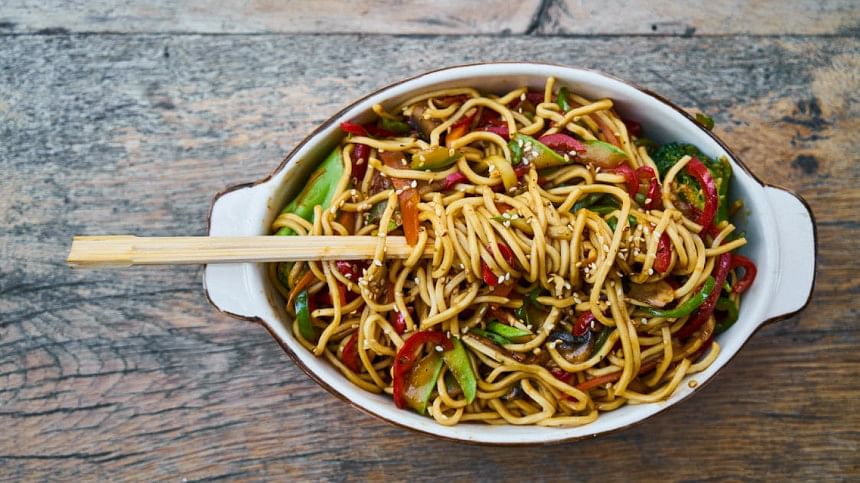Making yummy spicy kimchi noodle soup

This dish is a bit of a gold nugget, as making flavourful, spicy Asian soups is actually extremely challenging. A traditional Chinese soup broth cannot simply have a dab of chilli sauce added to it. You can, but it does not have the same punch as truly excellent hot Asian soups, which have strong savoury flavours that balance the heat. A lot of chilli oil, a clever mix of difficult-to-find Asian sauces, or a mound of bones cooked for hours to generate a handmade stock are often required to make a fantastic one.
This recipe for Spicy Korean soup broth is a gold mine!
Kimchi and gochujang are the two main components of this soup, and both can be found at most regular grocery stores. If only to cook this soup often, gochujang is a wickedly wonderful Korean paste to have in your refrigerator.
A traditional Korean pickle made from fermented vegetables and packed in hot, sour liquid is called kimchi. The most popular sort of cabbage works well in this soup. The cabbage works as a mop for the sauce, giving the liquid more taste.
The sauce is flavourful and should not be wasted. For an added kick of salt and heat, add it to stir-fries or Asian soups.
Gochujang is a hot Korean paste that is bursting with spice. It frequently appears in Korean dishes such as the Slow Cooked Beef Ribs in Korean BBQ Sauce, a hallmark meal from my cookbook (it's ridiculously simple with amazing results).
Ingredients
Chicken Broth: Use low-sodium chicken stock or broth; otherwise, once all the sauces are added, it can be excessively salty.
Fish sauce: It adds more taste and salt to the soup than simple salt or even soy sauce.
Soy Sauce: More salt is added to the soup with soy sauce (fish sauce alone is a touch too fishy). Use all-purpose soy sauce or light soy sauce. Avoid black soy sauce as the flavour is too powerful.
Garlic and ginger: To give the broth taste.
SOUP ADD-INS
Kimchi: As mentioned before, we season the broth as well as the cabbage using the juices from the jar. Maximum spiciness from Korea!
Noodles: Use any variety of noodles you choose. I prefer to use dried, thin, egg noodles for this. But you may use any kind of noodles in this recipe; just cook them by following the instructions on the packaging.
Choy Sum: Asian greens are great for quick-prep meals. Additionally, there is a nice contrast in textures between the floppiness of the leafy area and the crisp crunch of the stem. You may also use other Asian greens (such as bok choy, gai lan, or Chinese broccoli).
Carrot: For some crunch and beautiful colour contrast! If you do not want to bother, just slice it at an angle.
Fresh garnish: Green onions (optional).
Method
The flow of this dish is excellent and effective. Measure out and add the additional ingredients to the broth as it begins to simmer after adding the stock to the pan. The vegetables should then be chopped, and the noodles should be cooking while the broth simmers for 10 minutes to combine the flavours. then put the soup bowls together!
Cutting the choy sum: Remove the roots. Cut the stems from the leafy portion into pieces that are 7 cm/2.5 in long. Why? We put the stems first because they cook more slowly than the leaves, which wilt in a matter of seconds. So, at the very end, we add them to the pot.
Kimchi: Measure out two tablespoons of kimchi liquid and two-thirds of a cup of kimchi. If necessary, press and squeeze the cabbage to release the juice! Please do not cut it short; you need it for the taste.
Simmer broth for 10 minutes: Simmering the broth will harmonise the flavour. Combine all the ingredients for the broth in a pot. To extract the kimchi juices from the kimchi cabbage, I boil it with the other ingredients for the broth.
Cook the veg: Cook the carrots and the bok choy stems for two minutes before cooking the choy sum leafy portion for only one minute. Then it's over! The finished soup is available for assembling the noodle bowls.
Noodle preparation: While the soup is boiling, prepare the noodles per the directions on the packet, then drain.
Assemble: Put the noodles in a bowl to assemble. Then pour the soup liquid and all the toppings on top. If using, garnish with green onions before serving!
When you want something nutritious, fast, spicy, slurpy, or any combination of the above, this supper comes together in such a deliciously short amount of time. With the add-ins, it is quite adaptable. You may pick your own veggies, noodles, and meats if you choose.

 For all latest news, follow The Daily Star's Google News channel.
For all latest news, follow The Daily Star's Google News channel. 




Comments